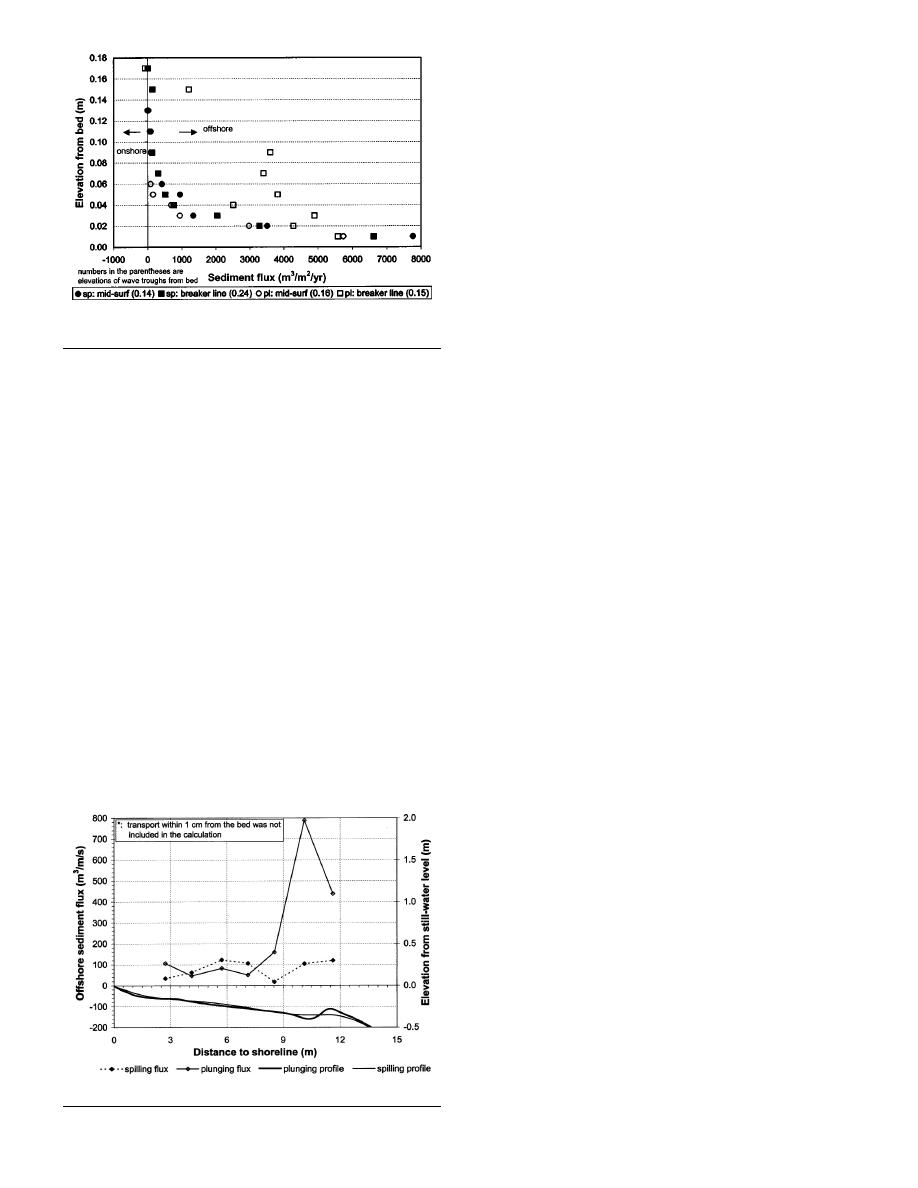
move offshore toward the bar crest, carried by the undertow. A
small portion was moved onshore, leading to the formation of a
secondary bar just landward of the trough. This secondary bar
was apparent during the higher wave run before the plunging case
Fig. 3 A , and became less distinctive when the wave height
was reduced Fig. 3 B . Ting and Kirby 1995 found that turbu-
lent energy generated by plunging breakers tends to be trans-
ported onshore, which may explain the onshore dispersion of
sediment suspended at the plunging point and development of the
secondary bar.
Onshore sand transport, in the form of a thin layer sliding
1:7 ,
across the bar crest and down the steep landward slope
was observed as the wave crests passed over the bar just before
breaking. The dynamic equilibrium of the bar/trough system was
maintained by the balance between the onshore transport attrib-
uted to gravity and the onshore component of the orbital velocity
Fig. 6. Product of time-averaged profiles of sediment concentration
at the landward bar slope and the offshore transport caused by a
and cross-shore current
combination of active sediment suspension by the plunging jet
and the undertow. These localized sediment motions need to be
considered in bar/trough models.
port near the water surface. An offshore-decreasing undertow
transport can be balanced by sediment suspension and horizontal
dispersion.
Summary
From the trends shown in Fig. 6, the circulation schematized
in the Fig. 1 of Larson et al. 1999 cannot be achieved without
The beach profiles reached equilibrium after approximately 1,330
considering the oscillatory terms. Fig. 7 shows depth-integrated
and 280 min of the spilling and plunging wave actions, respec-
offshore transport by undertow over the equilibrium beach. A
tively. The difference in time to reach equilibrium was influenced
peak and a trough occurred at around 6 and 8 m, respectively, for
by differences between the starting and ending profile shapes, and
the spilling case. Nearly no bed-level change was measured at
transport intensity. Different rates and patterns of profile evolu-
both locations Fig. 2 . For the plunging case, a high transport
tion were measured near the main spilling and plunging breaker
peak occurred just landward of the bar crest. This steep gradient
lines. Across most of the midsurf zone, the shapes of the equilib-
had to be balanced by onshore processes because bed-level
rium profiles were similar.
change was negligible at equilibrium. Fig. 7 also indicates that
Uniform energy dissipation per unit volume at equilibrium, as
gradients in undertow transport alone are not directly linked to
suggested by Dean 1977 , was measured across most of the surf
profile evolution. The cross-shore patterns of undertow speed did
zone except near the main breaker line, where a much faster dis-
not appear to correspond significantly to beach-profile evolution
sipation rate occurred. The measured equilibrium dissipation was
for both cases, when the time-series patterns were compared.
considerably smaller than the predictions from the Dean 1977
Observations of BarTrough Formation and Equilibrium
model. The product of the time-averaged profiles of cross-shore
current and sediment concentration yielded a net offshore-
under Plunging Breakers
directed sediment transport. The near-surface onshore transport
Formation of the bar/trough seemed to be related to local patterns
necessary for the non-local-balance equilibrium as suggested by
of sediment motion under the plunging breakers. The main plung-
Larson et al. 1999 could not be identified from the time-
ing point coincided with the trough location. A large portion of
averaged current and sediment concentration.
the suspended sediment agitated by the downward jet tended to
A pronounced bar developed during the plunging case.
Development/maintenance of the bar/trough system is related to
local patterns of sediment motion near the plunging breaker line.
Formation of the trough is related to the scour of the downward
jet at the plunge point, and the offshore dispersion of the sus-
pended sediment contributed to the bar building. The equilibrium
bar/trough system seemed to be maintained by a balance between
onshore transport attributed to gravity and the onshore component
of orbital velocity at the landward bar slope and the offshore
transport caused by the dramatic sediment suspension at the
trough induced by the plunging jet and the undertow.
Acknowledgments
The writers thank Carl Miller and Reggie Beach for providing the
FOBS sensors and Dr. N. C. Kraus for an earlier review. One of
the writers P.W. is partially funded by the Louisiana Sea Grant
College Program. Permission to publish this paper was granted by
Fig. 7. Offshore sediment transport by undertow
the Headquarters, U.S. Army Corps of Engineers.
JOURNAL OF WATERWAY, PORT, COASTAL AND OCEAN ENGINEERING / JANUARY/FEBRUARY 2003 / 45



 Previous Page
Previous Page
